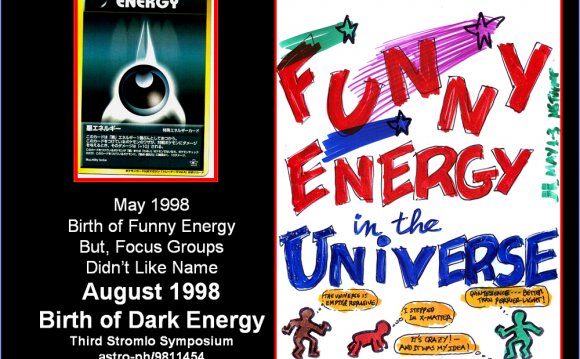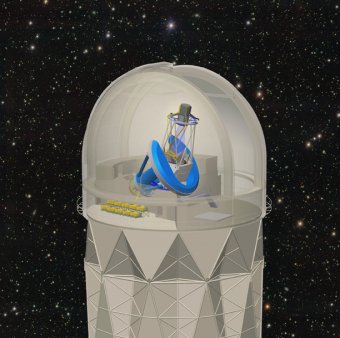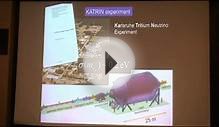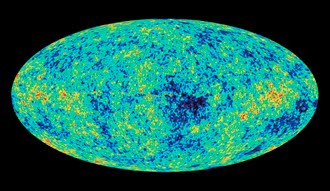
 DESI, the Dark Energy Spectroscopic Instrument, is an exceptional apparatus designed to improve our understanding of the role of dark energy in the expansion history of the universe; it will do this by measuring the redshifts of more than 30 million galaxies and quasars, with unprecedented precision. The U.S. Department of Energy has announced its approval of Critical Decision 2 (CD–2), authorizing the project’s scientific scope, schedule, and funding profile.
DESI, the Dark Energy Spectroscopic Instrument, is an exceptional apparatus designed to improve our understanding of the role of dark energy in the expansion history of the universe; it will do this by measuring the redshifts of more than 30 million galaxies and quasars, with unprecedented precision. The U.S. Department of Energy has announced its approval of Critical Decision 2 (CD–2), authorizing the project’s scientific scope, schedule, and funding profile.
Two hundred physicists and astronomers make up the international DESI Collaboration, which is based at DOE’s Lawrence Berkeley National Laboratory (Berkeley Lab). Using DESI’s redshift data they will create a three-dimensional map of the universe reaching deeper in space and time than any yet made. The map will reveal how dark energy and gravity have competed over time to shape the structure of the universe—both the regular clustering of galaxies and dark matter on the largest scales, and the idiosyncratic motion of individual galaxies.
DESI Director Michael Levi, of Berkeley Lab’s Physics Division, says, “We’ll study four kinds of targets to gather a continuous range of redshifts: nearby bright galaxies to redshift 0.4; luminous red galaxies to redshift 1; emission line galaxies to redshift 1.6; and very distant quasars all the way to redshift 3.5.”
Redshift, literally the shift of a distant astronomical object’s spectrum to longer (redder) wavelengths, is a direct measure of how much space stretched while the light was en route from object to observer. The bigger the redshift, the older the object. To capture light whose journey started up to 12 billion years ago—corresponding to a redshift of 3.5, when the universe was less than one seventh its present age—the DESI instrument will be mounted on the 4–meter Mayall telescope at Kitt Peak National Observatory near Tucson, Arizona.
DESI’s deep-space science
Daniel Eisenstein, of Harvard University, and Risa Wechsler, of Stanford University and DOE’s SLAC National Accelerator Laboratory, are the DESI Collaboration’s Spokespersons. Eisenstein says, “DESI aims to use the fossil imprint of sound waves from the first 400, 000 years of the universe”—still detectable as a pattern of temperature variations in the cosmic microwave background radiation (CMB)—“to study the mysterious composition of today’s universe.”
Those temperature differences map early variations in density (sound waves) that subsequently evolved into the clustering of galaxies, intergalactic gas, and dark matter at recurrent intervals throughout space. Called baryon acoustic oscillations (BAO), these regularly spaced clusterings are consistent over time—like a ruler to gauge the universe, with the CMB at one end—allowing direct measures of dark energy’s effect on expansion.
Wechsler says BAO is the beginning of what DESI can do. “Because large accumulations of mass have gravitational effects on individual galaxies, known as redshift space distortions, DESI can also test the accuracy of General Relativity, Einstein’s theory of gravity.”
In related investigations, DESI will “weigh” the total mass of neutrinos in the universe, with a good chance of learning which of the three known kinds of neutrinos is the heaviest. DESI will also compare models of the inflationary epoch, when the universe expanded exponentially within a sliver of a second after the big bang, leaving it extraordinarily uniform in composition.
Charting the universe in 3D
DESI’s technology is as intriguing as its science. The National Science Foundation’s (NSF’s) 4-meter Mayall telescope, operated by the National Optical Astronomy Observatory (NOAO), was completed in the early 1970s and recently recommended for divestment. NSF then made it possible for DOE to mount the DESI spectrometer on the telescope.
“The Mayall telescope is built like a battleship, ” says Natalie Roe, Director of Berkeley Lab’s Physics Division and a member the DESI Executive Committee. The telescope’s moving weight is 375 tons, and it is “so well engineered it can support this very heavy new instrument”—which weighs five tons—“suspended way up there in the air.”
The DESI spectrometer will upgrade this old battleship to world-leading capability. The telescope’s top end will be replaced with DESI’s optical corrector and focal-plane system. The corrector’s six glass lenses, each a meter across, will focus the light from the existing 4-meter mirror onto the new focal plane. The lenses were funded by the Gordon and Betty Moore Foundation and the Heising-Simons Foundation.
The focal plane, eight-tenths of a meter in diameter, will consist of 5, 000 tiny robot arms, each holding an optical fiber. The closely packed robots position the fiber ends to capture the spectrum of a single galaxy or quasar. After a 15 to 20-minute exposure, the telescope aims at a new patch of sky; in less than a minute the robots rotate and reposition thousands of fibers.
“What’s impressed me most over the years since DESI was first proposed is that the technical capability of the instrument is even better than we hoped, ” says Berkeley Lab’s David Schlegel. Schlegel and Brenna Flaugher, of the Fermi National Accelerator Laboratory, are DESI’s Project Scientists. “For example, the final design of the robot positioners has very few moving parts—about 25 parts overall, with only two critical connections.”
Says Flaugher, “Next year we’ll install a small version we call ProtoDESI, with 10 fiber positioners, on the Mayall telescope. It will let us test our ability to aim the fibers at galaxy targets, to keep the targets in focus and on the fibers as the telescope tracks the sky.”
The DESI redshift survey will richly complement other aspects of DOE’s interest in dark energy, including partnerships with NSF in such imaging surveys as the ongoing Dark Energy Survey, which uses the Dark Energy Camera on the Blanco telescope in Chile (the Mayall telescope’s South American twin), and the Large Synoptic Survey Telescope under construction in Chile, whose run is scheduled to start in 2021. DESI traces its heritage to the Baryon Oscillation Spectroscopic Survey (BOSS) of the Sloan Digital Sky Survey, but in number of galaxies and volume of space surveyed, DESI will be more than 10 times bigger than BOSS.
Key to DESI’s present and future success is its robust scientific collaboration, supported by many organizations, among them 31 universities and 18 government and private institutions, both U.S. and foreign, including five DOE national labs. DOE and NSF will shortly begin joint support for Mayall telescope operations, preparatory work, and installation of the DESI instrument. Beginning in fiscal year 2019, DOE will support the full operations of the telescope throughout the five-year DESI survey.
###
Lawrence Berkeley National Laboratory addresses the world’s most urgent scientific challenges by advancing sustainable energy, protecting human health, creating new materials, and revealing the origin and fate of the universe. Founded in 1931, Berkeley Lab’s scientific expertise has been recognized with 13 Nobel prizes. The University of California manages Berkeley Lab for the U.S. Department of Energy’s Office of Science. For more, visit .
DOE’s Office of Science is the single largest supporter of basic research in the physical sciences in the United States, and is working to address some of the most pressing challenges of our time. For more information, please visit science.energy.gov.
INTERESTING VIDEO



 Physical cosmology, as a branch of astronomy, is the study of the largest-scale structures and dynamics of the universe and is concerned with fundamental questions about its formation and evolution. For most of human history, it was a branch of metaphysics and...
Physical cosmology, as a branch of astronomy, is the study of the largest-scale structures and dynamics of the universe and is concerned with fundamental questions about its formation and evolution. For most of human history, it was a branch of metaphysics and...








